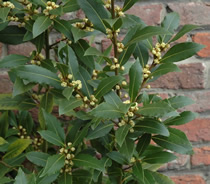Bay Laurel and Poison Oak
Winter and early spring can be especially daunting for those sensitive to poison oak. On the one hand, cold, wet weather means we have more clothing (and gloves) on and therefore have less risk of direct skin contact. However, the urushiol can easily rub off on fabrics and lie in wait for days, transferring on to your bare forearm the next time you throw that jacket on, for example. You can also spread the oil to other people! What really increases the exposure risk in the winter is that the distinctive 3-lobed green (late spring/summer) or red (fall) leaves are gone, making the shrubs that much harder to notice. They pretty much look like dead sticks lying at the base of a tree or shrub with a bunch of other dead sticks. Sigh. Calamine and hydrocortisone creams are the standard treatment for poison oak. But for those of us who have gardens, especially larger edible gardens with herbs, a different antidote might be growing not far away. The Bay Laurel Tree (Laurus nobilis) is native to the Mediterranean, and its dried leaves are used in cooking as pungent and savory flavoring for soups, stews, and sauces. The leaves are usually simmered in the dish and removed before serving. But bay leaves aren’t only used in culinary applications, and in fact have medicinal properties as well. The primary terpene responsible for both the aromatic and healing powers of this tree is eucalyptol. When the leaves are made into a poultice, breathing in the fumes of the poultice are said to greatly help with a variety of breathing issues, acting primarily as a vasodilator. A poultice of the leaves is also said to be useful when applied to the skin topically, acting as an astringent and helping with a variety of rashes. The rash which is caused by poison oak oils is no match for a batch of bay leaves, slowly boiled in water until the liquid in the pot is quite low. Soak a rag in this solution (cooled enough so it won’t injure the skin, but still quite warm) and apply it gently to the affected area. The heat of the poultice provides immediate relief, and the eucalyptol acts as a numbing agent and helps combat the urushiol biochemically. Laurus nobilis can be found in many nurseries, and grows well in any Mediterranean climate with warm, dry summers and cool, wet winters like those we have in much of California. The trees can be kept smaller in stature with regular topping and pruning, supplying a steady supply of leaves to make delicious soups or combat poison oak rashes for years to come. IMPORTANT NOTE: There is a BIG difference between the Mediterranean Bay Laurel Tree (Laurus nobilis) which we are discussing, and the tree known as either the "California Bay Laurel" or the "Oregon Myrtle" (Umbellularia californica), which is a large hardwood tree native to oak woodlands and coastal forests of California, extending into Oregon. The California Bay Laurel also has extremely aromatic leaves, which possess their own medicinal properties, and is deserving of its own feature in a future column. Sometimes people substitute them for Bay Laurel in cooking, but you should not use them for treating poison oak as described above! The vapors from boiling California Bay Laurel leaves can cause harmful respiratory reactions in people and animals, and should be avoided. Only use Lauris nobilis leaves for treating poison oak. Note: The content in this article is meant to inform, not to diagnose or treat any ailment. Always use common sense, and consult with your healthcare provider before attempting to treat yourself or others. top | Newsletter Home |Table of Contents| Archive
|


 If you live in a part of California which receives regular
If you live in a part of California which receives regular